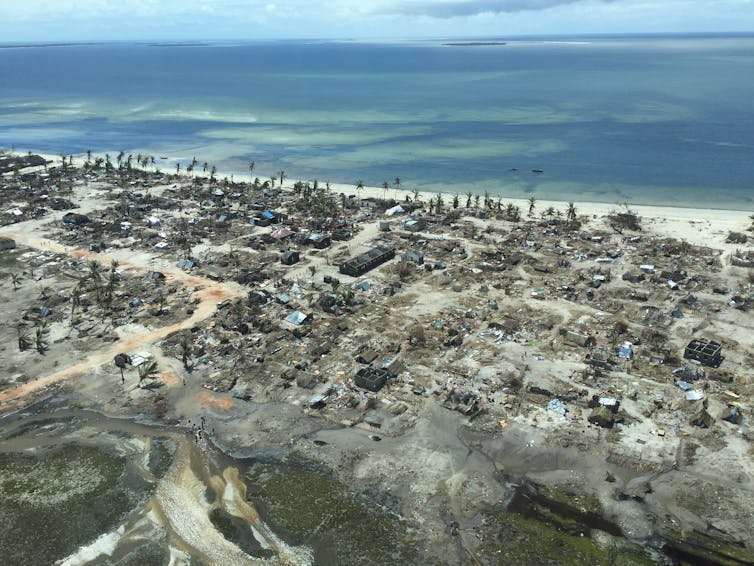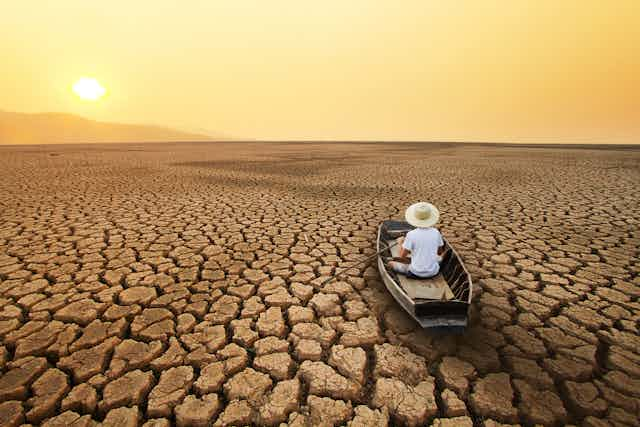The latest UN report on the potential impacts of climate change gives a grim verdict, with some effects now deemed unavoidable. But there are also lessons on disasters and violent conflicts which could help save lives and create safer societies regardless of human-caused climate change.
The main available text of the Intergovernmental Panel on Climate Change (IPCC) report on “Impacts, Adaptation and Vulnerability” is a 35-page Summary for Policy Makers, which by IPCC rules, is approved by member state governments.
IPCC scientists are appointed by member states and these contributing researchers do not produce new science. They summarise the tens of thousands of peer-reviewed scientific papers on climate change since the previous assessment (the last major IPCC report on impacts, adaptation and vulnerabilities was published in 2014).
The scientists then receive thousands of review comments on drafts requiring textual revisions or responses. In making a series of statements on our understanding of climate change, the report assigns confidence levels such as “low” or “very high” to indicate how certain the authors are of each one.
The current report has been overshadowed by Ukrainian scientists having to leave the approval session to take care of themselves and their families during Russia’s invasion of their country. Nonetheless, around 90 scientists from all inhabited continents and balanced between women and men drafted the document. As frequently occurs, reports emerged of political pushes to remove scientific content which emphasises the political nature of the material.
Disasters and climate change
As an academic who researches disasters and health, I was particularly interested in how the report examined climate change as a cause of disasters, including violent conflicts, and set out actions to avoid them.
The IPCC’s summary entirely avoids the phrase “natural disaster”. This reflects decades of work explaining that disasters are caused by sources of vulnerability – such as unequal and inequitable access to essential services like healthcare or poorly designed or built infrastructure like power plants – rather than by the climate or other environmental influences.
The report states, with high confidence, that “climate change is contributing to humanitarian crises where climate hazards interact with high vulnerability”. In other words, vulnerability must exist before a crisis can emerge. Climate change is not the root cause of disaster. The report explains that places with “poverty, governance challenges and limited access to basic services and resources, violent conflict and high levels of climate-sensitive livelihoods” are more vulnerable to climate change impacts.

For example, cyclones still lead to disasters in Bangladesh. Nevertheless, the country has substantially reduced deaths and damage through concerted efforts to reduce vulnerabilities. These include building thousands of storm shelters and issuing early warnings by multiple means. These measures have made cyclones less deadly even as the storms have become more intense due to climate change.
Weather disasters which kill more people tend to occur where communities and infrastructure are more vulnerable, according to the report. Heat is rightly highlighted as a major concern, since it causes crops to fail and forces people to halt work. That said, it is surprising that the health impacts of humidity, which can combine with extreme heat to deadly effect, are not mentioned.
The report explains that disaster risk and impacts can be reduced by tackling fundamental issues which cause vulnerability, no matter what the weather and climate do. It places high confidence in risk management, risk sharing, and warning strategies as key tasks for adapting to climate change.
Violent conflict and climate change
As with disasters, the report cannot attribute violent conflict to climate change. With high confidence, the report states that “compared to other socioeconomic factors the influence of climate on conflict is assessed as relatively weak”. This corroborates other research which argues peace and conflict are more determined by social and political factors than by climate or weather.
The authors identify, with high confidence, actions to reduce the “underlying vulnerabilities” which raise the risk of violent conflict. These can be based on research and might include redistributing wealth and resources to make societies more equal and equitable, while providing diverse livelihoods. Adapting to climate change is only part of the solution. Scientific analyses note how development, rather than climate change adaptation only, is the most effective overall.

In fact, despite frequent assumptions that climate change caused or was linked to violent conflicts in the past, the summary implies that no single conflict should be attributed to climate change, natural or anthropogenic. This conclusion matches analyses for Darfur in 2003 and Syria in 2011.
Summary of the summary
The IPCC’s press release on the new report was headlined “Climate change: a threat to human wellbeing and health of the planet”. Its stark opening detailed “dangerous and widespread disruption”. Yet its subtitle, “Taking action now can secure our future,” needs emphasising. This is particularly the case for disasters and violent conflicts which, the summary document states with high confidence, are not significantly influenced by human-caused climate change.
Perhaps the press release mentions neither disasters nor violent conflict because they represent comparatively positive news among the bleakness. Ultimately, “taking action now” means applying the science of disasters and conflict for prevention. Then, we save lives and livelihoods, no matter what climate change does.

Don’t have time to read about climate change as much as you’d like?
Get a weekly roundup in your inbox instead. Every Wednesday, The Conversation’s environment editor writes Imagine, a short email that goes a little deeper into just one climate issue. Join the 10,000+ readers who’ve subscribed so far.

